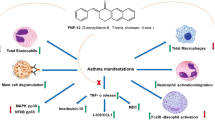Abstract
Clara cell 16-kDa (CC16) is an anti-inflammatory protein chiefly produced in the lung epithelium. CC16 has been shown to inhibit the migration of rabbit neutrophils and human monocytes toward the formyl peptide N-formyl-methionine-leucin-phenylalanin (fMLF). Eosinophils migrate towards prostaglandin D2 (PGD2) and CC16 has been shown to bind to PGD2. Therefore we investigated if CC16 could inhibit the migration of human eosinophils and neutrophils towards fMLF and/or PGD2. Migration of eosinophils and neutrophils was assessed in a microplate migration system using specific ligands and receptor antagonists. CC16 inhibited the migration of eosinophils and neutrophils toward fMLF, which is likely to result from the interaction of CC16 with members of the formyl-peptide receptor family. However, CC16 did not inhibit eosinophil migration towards PGD2. We therefore propose that CC16 may down-modulate the entry of human eosinophils and neutrophils into the airways during inflammation in the lung.


Similar content being viewed by others
References
Charlesworth, E. N., A. F. Hood, N. A. Soter, A. Kagey-Sobotka, P. S. Norman, and L. M. Lichtenstein. 1989. Cutaneous late-phase response to allergen. Mediator release and inflammatory cell infiltration. J. Clin. Invest. 83:1519–1526. doi:10.1172/JCI114047.
Robinson, D. S., Q. Hamid, S. Ying, A. Tsicopoulos, J. Barkans, A. M. Bentley, et al. 1992. Predominant TH2-like bronchoalveolar T-lymphocyte population in atopic asthma. N. Engl. J. Med. 326:298–304.
Svensson, L., A. Rudin, and C. Wennerås. 2004. Allergen extracts directly mobilize and activate human eosinophils. Eur. J. Immunol. 34:1744–1751. doi:10.1002/eji.200324798.
Svensson, L., E. Redvall, C. Björn, J. Karlsson, A. M. Bergin, M. J. Rabiet, et al. 2007. House dust mite allergen activates human eosinophils via formyl peptide receptor and formyl peptide receptor-like 1. Eur. J. Immunol. 37:1966–1977. doi:10.1002/eji.200636936.
Peri, A., E. Cordella-Miele, L. Miele, and A. B. Mukherjee. 1993. Tissue-specific expression of the gene coding for human Clara cell 10-kD protein, a phospholipase A2-inhibitory protein. J. Clin. Invest. 92:2099–2109. doi:10.1172/JCI116810.
Mukherjee, A. B., G. C. Kundu, G. Mantile-Selvaggi, C. J. Yuan, A. K. Mandal, S. Chattopadhyay, et al. 1999. Uteroglobin: a novel cytokine? Cell Mol. Life Sci. 55:771–787. doi:10.1007/s000180050331.
Shijubo, N., Y. Itoh, T. Yamaguchi, and S. Abe. 2000. Development of an enzyme-linked immunosorbent assay for Clara cell 10-kDa protein: in pursuit of clinical significance of sera in patients with asthma and sarcoidosis. Ann. N. Y. Acad. Sci. 923:268–279.
Johansson, S., C. Keen, A. Ståhl, G. Wennergren, and M. Benson. 2005. Low levels of CC16 in nasal fluid of children with birch pollen-induced rhinitis. Allergy. 60:638–642. doi:10.1111/j.1398-9995.2005.00775.x.
Chen, L. C., Z. Zhang, A. C. Myers, and S. K. Huang. 2001. Cutting edge: altered pulmonary eosinophilic inflammation in mice deficient for Clara cell secretory 10-kDa protein. J. Immunol. 167:3025–3028.
Mandal, A. K., Z. Zhang, R. Ray, M. S. Choi, B. Chowdhury, N. Pattabiraman, et al. 2004. Uteroglobin Represses Allergen-induced inflammatory response by blocking PGD2 receptor-mediated Functions. J. Exp. Med. 199:1317–1330. doi:10.1084/jem.20031666.
Monneret, G., S. Gravel, M. Diamond, J. Rokach, and W. S. Powell. 2001. Prostaglandin D2 is a potent chemoattractant for human eosinophils that acts via a novel DP receptor. Blood. 98:1942–1948. doi:10.1182/blood.V98.6.1942.
Gervais, F. G., R. P. Cruz, A. Chateauneuf, S. Gale, N. Sawyer, F. Nantel, et al. 2001. Selective modulation of chemokinesis, degranulation, and apoptosis in eosinophils through the PGD2 receptors CRTH2 and DP. J. Allergy Clin. Immunol. 108:982–988. doi:10.1067/mai.2001.119919.
Schratl, P., J. F. Royer, E. Kostenis, T. Ulven, E. M. Sturm, M. Waldhoer, et al. 2007. The role of the prostaglandin D2 receptor, DP, in eosinophil trafficking. J. Immunol. 179:4792–4799.
Royer, J. F., P. Schratl, S. Lorenz, E. Kostenis, T. Ulven, R. Schuligoi, et al. 2007. A novel antagonist of CRTH2 blocks eosinophil release from bone marrow, chemotaxis and respiratory burst. Allergy. 62:1401–1409. doi:10.1111/j.1398-9995.2007.01452.x.
Vasanthakumar, G., R. Manjunath, A. B. Mukherjee, H. Warabi, and E. Schiffmann. 1988. Inhibition of phagocyte chemotaxis by uteroglobin, an inhibitor of blastocyst rejection. Biochem. Pharmacol. 37:389–394. doi:10.1016/0006-2952(88)90204-3.
Zhu, X., E. Boetticher, L. Wang, Y. Duan, J. Learoyd, and A. R. Leff. 2008. Pyk2 Regulates spreading and migration of eosinophils after {beta}2 integrin adhesion. Am. J. Respir. Cell Mol. Biol.
Migeotte, I., D. Communi, and M. Parmentier. 2006. Formyl peptide receptors: a promiscuous subfamily of G protein-coupled receptors controlling immune responses. Cytokine Growth Factor Rev. 17:501–519. doi:10.1016/j.cytogfr.2006.09.009.
Ray, R., Z. Zhang, Y. C. Lee, J. L. Gao, and A. B. Mukherjee. 2006. Uteroglobin suppresses allergen-induced TH2 differentiation by down-regulating the expression of serum amyloid A and SOCS-3 genes. FEBS Lett. 580:6022–3026. doi:10.1016/j.febslet.2006.09.059.
Gao, J. L., and P. M. Murphy. 1993. Species and subtype variants of the N-formyl peptide chemotactic receptor reveal multiple important functional domains. J. Biol. Chem. 268:25395–25401.
Hirai, H., K. Tanaka, O. Yoshie, K. Ogawa, K. Kenmotsu, Y. Takamori, et al. 2001. Prostaglandin D2 selectively induces chemotaxis in T helper type 2 cells, eosinophils, and basophils via seven-transmembrane receptor CRTH2. J. Exp. Med. 193:255–261. doi:10.1084/jem.193.2.255.
Acknowledgement
We thank the healthy volunteers for taking part in the study. We also thank Aprile L Pilon at Claragen Inc for providing recombinant human CC16. This study was supported by the Swedish Research Council (grant K2002-745X-14455-01A), by the Swedish Foundation for Health Care Sciences and Allergy Research, by Cancer-och Allergifonden, by the Swedish Asthma and Allergy Association, by the Sahlgrenska Academy, University of Gothenburg and by Frimurare Barnhusdirektionen.
Author information
Authors and Affiliations
Corresponding author
Rights and permissions
About this article
Cite this article
Johansson, S., Andersson, K., Wennergren, G. et al. CC16 Inhibits the Migration of Eosinophils Towards the Formyl Peptide fMLF but not Towards PGD2 . Inflammation 32, 65–69 (2009). https://doi.org/10.1007/s10753-008-9103-1
Published:
Issue Date:
DOI: https://doi.org/10.1007/s10753-008-9103-1




